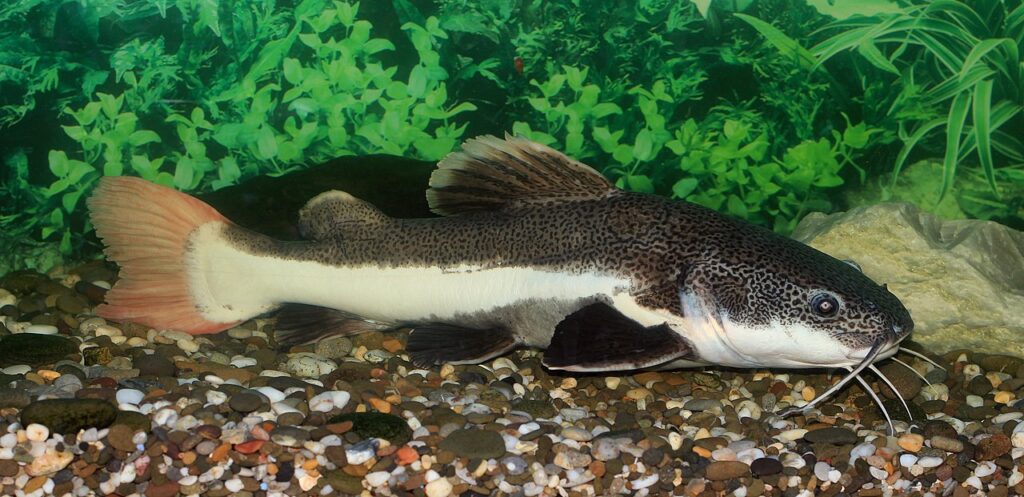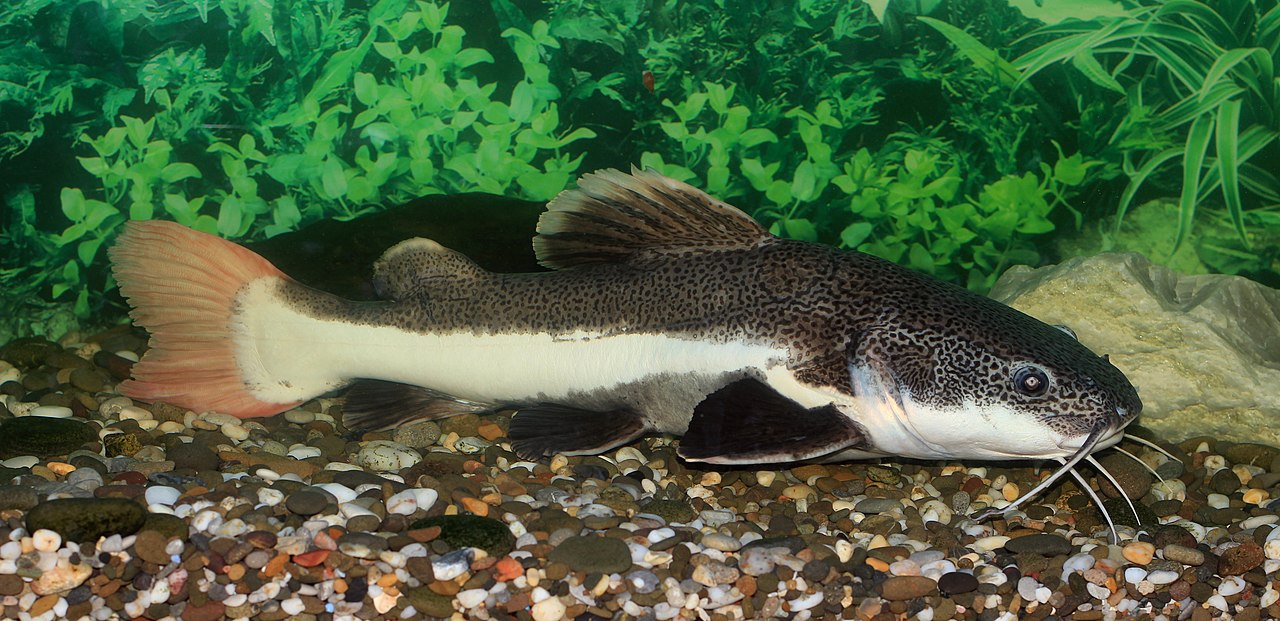The Red Tail Catfish, scientifically known as Phractocephalus hemioliopterus, is a captivating species that belongs to the Pimelodidae family. This long-whiskered catfish, the only existing species of the genus Phractocephalus, is known by various names across different regions. In Venezuela, it’s called cajaro, in Guyana, it’s the banana catfish, and in Brazil, it’s known as pirarara.
Table of Contents
One of the most striking features of the Red Tail Catfish is its color. It boasts a brownish back, yellow sides, and characteristic orange-red dorsal and caudal fins. Sometimes, the dorsal, pelvic, and anal fins also exhibit a red hue. Its broad head with long whiskers, dark black body, and white underside extending from the mouth to the caudal fin contribute to its unique appearance.
The Red Tail Catfish is not currently evaluated by the IUCN, indicating that it’s not considered endangered or threatened. While the Red Tail Catfish is the only living representative of its genus, there are fossil remains of other members dating back to the upper Miocene. These include P. nassi and P. acreornatus.
Native to the Amazon, Orinoco, and Essequibo river basins of South America, the Red Tail Catfish is a bottom-dweller that moves quite slowly. It’s territorial and prefers to feed during the evening and night, remaining motionless during the day. Its diet includes fish, crustaceans, and fallen fruits.
The Red Tail Catfish can reach about 1.8 m in length and about 80 kg in weight, although most do not approach this size. They average 1.1–1.4 m in length. Interestingly, the Red Tail Catfish has been hybridized with other fish, such as the Pseudoplatystoma or Tiger Shovelnose Catfish, to create the Tiger Red Tail Catfish. These hybrid fish sometimes make it into the aquarium hobby under a variety of common names.
The Red Tail Catfish has a minimum age of about 13.5 million years, dating back to the upper Miocene. Despite its massive adult size, it’s common in the aquarium trade, often housed with other large fish in Amazonian-themed exhibits at public aquaria.

Key Information
The Redtail Catfish, known scientifically as Phractocephalus hemioliopterus, is a unique species with a rich history. While it is the only living representative of its genus, there are fossil remains of other members dating back to the upper Miocene. These include P. nassi and P. acreornatus. These variants, now extinct, provide a fascinating glimpse into the evolutionary history of this remarkable fish. Today, the Redtail Catfish continues to captivate aquarists with its striking appearance and intriguing behavior.
| Family | Pimelodidae |
| Price | Varies, often around $20-$30 for juveniles, adults can be much more expensive |
| Common Names | Redtail Catfish, Cajaro, Banana Catfish, Pirarara |
| Variants | Fossil variants include P. nassi and P. acreornatus |
| Ideal Tank Size | At least 10,000 L (2,600 US gal) for fully grown adults |
| Water Parameters | Freshwater, pH 6.0-7.5, temperature 20-26°C (68-79°F) |
| Lifespan | Up to 15 years in captivity |
| Full Size | Up to 1.8 m (5 ft 11 in) in length |
| Natural Environment | Amazon, Orinoco, and Essequibo river basins of South America |
| Behavior | Territorial, bottom-dweller, nocturnal feeder |
| Habitat Preference | Bottom of larger rivers, streams, and lakes |
| Aquarium Decoration | Minimal, to accommodate their large size. Avoid small, swallowable objects |
| Ideal Tank Mates | Other large fish species, such as pacu |
| Fish to Avoid | Small fish that can be swallowed, aggressive species |
| Best Foods/Diet | Fish, crustaceans, fallen fruits |
| Disease | Susceptible to common fish diseases, proper water quality is crucial |
| Sex-switch | No known sex-switching behavior |
| Gender Differences | No significant external differences |
| Care Level | High, due to their large size and specific requirements |
| Breeding Level | Difficult, not commonly bred in home aquariums |
Ideal Tank Mates
The Redtail Catfish is a large, territorial species that requires specific tank mates to ensure a harmonious aquarium environment. When choosing tank mates for your Redtail Catfish, it’s crucial to consider the size, temperament, and environmental needs of the other species. Here are some ideal tank mates for the Redtail Catfish:
1. Pacu
Pacus are large, peaceful fish that can coexist well with Redtail Catfish. They are not aggressive and can hold their own due to their size.
2. Oscar Fish
Oscars are another large species that can make good tank mates for Redtail Catfish. They are robust and can handle the catfish’s territorial nature.
3. Plecostomus
Plecos, especially larger species, can be good tank mates for Redtail Catfish. They tend to keep to themselves and are bottom dwellers like the Redtail Catfish.
4. Arowana
Arowanas are large, surface-dwelling fish that can coexist well with Redtail Catfish. They occupy a different area of the tank, reducing territorial disputes.
5. Giant Gourami
These large, peaceful fish can make good tank mates for Redtail Catfish. They are hardy and can handle a variety of water conditions.
6. Black Sharkminnow
This species is large enough to avoid being eaten and can hold its own against a Redtail Catfish.
7. Clown Knifefish
Clown Knifefish are large, nocturnal fish that can coexist well with Redtail Catfish. They have a similar diet and habitat preferences.
8. Cichlids
Larger cichlids, like the Jack Dempsey or Green Terror, can be good tank mates for Redtail Catfish. They are robust and can handle the catfish’s territorial nature.
9. Bichirs
Bichirs are bottom dwellers like the Redtail Catfish and can make good tank mates due to their size and hardy nature.
10. Freshwater Stingrays
Stingrays are bottom dwellers that can coexist with Redtail Catfish. However, they require a very large tank with a sandy bottom.
11. Tiger Shovelnose Catfish
This is another large catfish species that can coexist with Redtail Catfish. They have similar care requirements.
12. Datnoids
Datnoids are large, peaceful fish that can make good tank mates for Redtail Catfish. They are not aggressive and can hold their own due to their size.
13. Tinfoil Barbs
Tinfoil Barbs are large, schooling fish that can coexist with Redtail Catfish. They are fast swimmers and can avoid the catfish if necessary.
14. Freshwater Eels
Larger species of freshwater eels can make good tank mates for Redtail Catfish. They are bottom dwellers and can hold their own due to their size.
15. Silver Dollars
Silver Dollars are schooling fish that can coexist with Redtail Catfish. They are fast swimmers and can avoid the catfish if necessary.
16. Gar
Gars are large, predatory fish that can hold their own with Redtail Catfish. They occupy a different area of the tank, reducing territorial disputes.
17. Large Loaches
Larger species of loaches, like the Clown Loach, can make good tank mates for Redtail Catfish. They are bottom dwellers and can hold their own due to their size.
18. Large Catfish
Other large species of catfish, like the Blue Catfish or Channel Catfish, can coexist with Redtail Catfish. They have similar care requirements.
19. Large Characins
Larger species of characins, like the Black Pacu, can make good tank mates for Redtail Catfish. They are robust and can handle the catfish’s territorial nature.
20. Large Loricariids
Larger species of loricariids, like the Sailfin Pleco, can coexist with Redtail Catfish. They are bottom dwellers and can hold their own due to their size.
Remember, while these species can potentially make good tank mates for Redtail Catfish, individual temperaments can vary, and careful observation is necessary when introducing new fish to the tank.
FAQs
How fast does a Redtail Catfish grow?
In their first year, Redtail Catfish can grow up to 24 inches. Their growth rate slows down as they age, but they continue to grow throughout their life.
Can I keep multiple Redtail Catfish together?
It’s not recommended to keep multiple Redtail Catfish in the same tank unless it’s a very large pond or commercial aquarium. They are territorial, and as they grow, they may become aggressive towards each other.
Are Redtail Catfish jumpers?
Yes, Redtail Catfish are known to jump, especially when they are young or feel threatened. It’s essential to have a secure lid on your aquarium to prevent them from jumping out.
How can I tell if my Redtail Catfish is stressed?
Signs of stress in a Redtail Catfish include rapid breathing, loss of appetite, faded colors, and erratic swimming. Ensure that the water parameters are optimal and that there are no aggressive tank mates causing the stress.
Do Redtail Catfish have teeth?
Yes, they have sharp teeth that they use to catch prey in the wild. It’s essential to be cautious when hand-feeding or handling them.
How often should I feed my Redtail Catfish?
Juvenile Redtail Catfish should be fed daily, while adults can be fed every other day or three times a week. Ensure they receive a varied diet to meet their nutritional needs.
Can Redtail Catfish be trained?
Many aquarists have reported success in training their Redtail Catfish to recognize them and even accept food from their hands. With patience and consistent interaction, they can become quite interactive with their owners.
What’s the best substrate for a Redtail Catfish tank?
A soft, sandy substrate is ideal for Redtail Catfish as they like to sift through the sand. Avoid sharp or jagged substrates that could injure them.
Is it safe to use decorations with sharp edges in a Redtail Catfish tank?
It’s best to avoid decorations with sharp edges or small crevices. Redtail Catfish are active swimmers and can accidentally injure themselves on sharp objects. Opt for smooth, rounded decorations and ensure there’s plenty of open space for them to swim.
How do I transport a large Redtail Catfish if I need to move?
Transporting a large Redtail Catfish can be challenging. Use a large, thick plastic bag or container filled with tank water. Ensure there’s enough oxygen in the bag or container. It’s also advisable to cover the container to reduce stress. Always handle the fish gently and minimize the time it spends out of its main tank.
Can Redtail Catfish live in outdoor ponds?
Yes, Redtail Catfish can thrive in outdoor ponds, provided the water temperature and conditions are suitable. Ensure the pond is secure to prevent them from escaping and safe from potential predators.
Do Redtail Catfish have a good sense of hearing?
Redtail Catfish have an acute sense of hearing. They can detect vibrations in the water, which helps them locate prey. This is why they often respond to sounds or movements around their tank.
Can I use regular tap water for my Redtail Catfish tank?
While tap water can be used, it’s essential to treat it with a water conditioner to remove harmful chemicals like chlorine. Always ensure the water parameters, such as pH and hardness, are suitable for Redtail Catfish.
How can I enrich the environment for my Redtail Catfish?
Providing a varied diet, introducing safe toys or objects that they can explore, and occasionally rearranging the tank setup can offer enrichment. Interaction, like hand-feeding, can also be stimulating for them.
Are there any specific medications I should avoid using with Redtail Catfish?
Always be cautious when medicating your tank. Some medications containing copper can be harmful to catfish. It’s best to consult with a veterinarian or experienced aquarist before administering any medication.

Leave a Reply